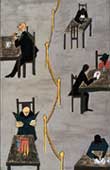|
|
|
Introduction Task Process Resources Evaluation Reflection
Although most southern blacks migrated North
with high hopes, many were disappointed to find that it had its own brand
of discrimination. Many northern whites reacted with prejudice toward the
migrants.
This panel shows a public restaurant or dining space in the North. Blacks
and whites are divided by a yellow barrier that zigzags through the center
of the painting. The tables and chairs are placed so that the people sitting
at them do not face each other. In this way, Jacob Lawrence increased the
people’s separation in this space.
DISCRIMINATION
Unfair treatment or behavior based on race, color, ethnic background, age,
or gender.
PREJUDICE
A negative opinion or attitude about a person or group of people, based
on insufficient knowledge rather than fact.
Back to the Beginning
In this webquest you will:
- Examine how Jacob Lawrence has shown discrimination in his Migration
Series.
- Read stories and look at websites about ways that people have challenged
discrimination.
- Create and perform a short play about challenging discrimination and/or
prejudice.
- Review and discuss your play.
Back to the Beginning
|
|
 |
They also
found discrimination in the North although it was much different from
that which they had known in the South.
The Migration of the Negro, panel 49, 1940-41
Casein tempera on hardboard
18 x 12 in. (45.7 x 30.5 cm)
The Phillips Collection, Washington, D.C.
© Gwendolyn Knight Lawrence, courtesy of the Jacob and Gwendolyn
Lawrence Foundation |
|
| |
|
- Look at
 Jacob
Lawrence's painting, panel #49 from The Migration Series.
Move your mouse over the painting and find questions to discuss with
your classmates. Jacob
Lawrence's painting, panel #49 from The Migration Series.
Move your mouse over the painting and find questions to discuss with
your classmates.
- Divide into small groups of 4-6 people. With your teacher, research
and read some of the stories in the bibliography below. Explore some
of the websites listed below to find out how three American heroes challenged
discrimination.
- Have a class discussion about challenging discrimination. Use the
following questions for your discussion:
What challenges did these American heroes face?
How did they deal with discrimination?
What kinds of discrimination and prejudice exist today?
How do people deal with discrimination today?
- Go to this website to read some kids’ opinions about how they
would challenge discrimination and prejudice:
 http://teacher.scholastic.com/newszone/specialreports/ http://teacher.scholastic.com/newszone/specialreports/
equality/comment.htm
- In your small groups, discuss and write a short play about a situation
of prejudice or discrimination that has happened in history, or in your
everyday lives. In your play, include at least one way to challenge
this discrimination.
- Design a backdrop for your play. Use art materials, props, a slide
projector, or your classroom furniture.
- Perform and discuss your plays with your classmates.
What situations did you choose? Why?
How did you deal with discrimination or prejudice?
Would your ways of dealing with discrimination or prejudice be successful
in a real life situation? Why or why not?
Back to the Beginning
Gloria Anzaldua, Friends From the Other Side/Amigos Del Otro Lado,
San Francisco: Children's Book Press, 1993
Tomie dePaola, Oliver Button is a Sissy, New York: Harcourt Brace
Jovanovich, 1979
Virginia Fleming, Be Good to Eddie Lee, New York: Philomel Books,
1993
Peter Golenbock, Teammates, San Diego, CA: Harcourt Brace Jovanovich,
1990
Mary Hoffman, Amazing Grace, New York: Dial Books for Young Readers,
1991
Margy Burns Knight, Who Belongs Here? Gardiner, ME: Tilbury House
Publishers, 1993
Margaret Merrifield, Come Sit By Me, Toronto: Women's Press, 1990
Judith Vigna, Black Like Kyra, White Like Me, Morton Grove, IL: Albert
Whitman and Company, 1992
Rosa Parks.
 http://www.time.com/time/time100/heroes/profile/parks01.html http://www.time.com/time/time100/heroes/profile/parks01.html
Jackie Robinson.
 http://www.time.com/time/time100/heroes/profile/robinson01.html http://www.time.com/time/time100/heroes/profile/robinson01.html
Martin Luther King.
 http://teacher.scholastic.com/researchtools/articlearchives/ http://teacher.scholastic.com/researchtools/articlearchives/
honormlk/struggle.htm
Stomping out hate.
 http://teacher.scholastic.com/newszone/specialreports/ http://teacher.scholastic.com/newszone/specialreports/
equality/stomp.htm
Working for equality.
 http://teacher.scholastic.com/newszone/specialreports/ http://teacher.scholastic.com/newszone/specialreports/
equality/hurts.htm
Back to the Beginning
You will receive two evaluations: a group evaluation and an individual evaluation.
Your teacher may also choose to create rubrics for evaluation or evaluate
your contributions to group discussions about American heroes and discrimination.
- Group Evaluation: Creative Play Writing: Does your play show that
you have a solid understanding of discrimination and prejudice?
- Does your play also show how people can challenge discrimination or
prejudice in a positive, productive way?
- Is your play interesting and entertaining for your audience and does
it engage them in the subject matter?
- Does the backdrop you designed for your play show evidence of creativity
and originality given the limited resources you may have available to
you?
- During the process of creating the play did your group show evidence
of teamwork, collaboration, and time management?
- Individual Evaluation: You will be evaluated on your collaborative
efforts and contributions to your group.
- What unique contributions did you make to the group? Did you demonstrate
leadership, teamwork and collaboration?
 Learning
Standards Addressed Learning
Standards Addressed
Back to the Beginning
How would you continue to challenge discrimination and prejudice in your
daily lives?
Go to the website below and share your ideas about challenging discrimination
with others.
 http://teacher.scholastic.com/newszone/specialreports/ http://teacher.scholastic.com/newszone/specialreports/
equality/sendcomments.asp
Stage and perform your plays for a wider audience at your school. Invite
other classes and teachers to see your plays. Ask your teacher or your peers
to take photographs of your performances. Make a photo wall in your classroom
or a computer presentation. If you include sound, use your own voices performing
the play.
Back to the Beginning |
|









